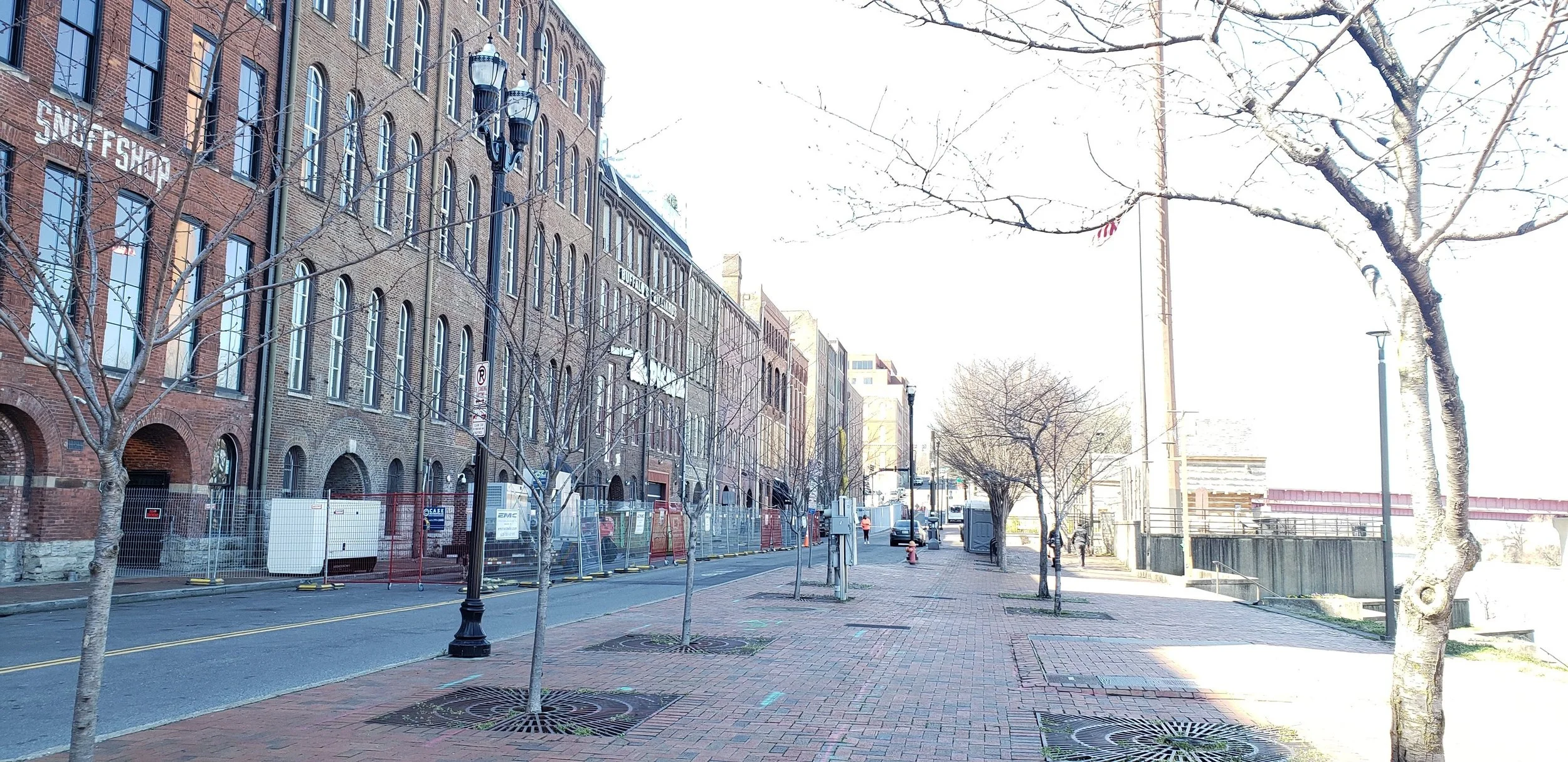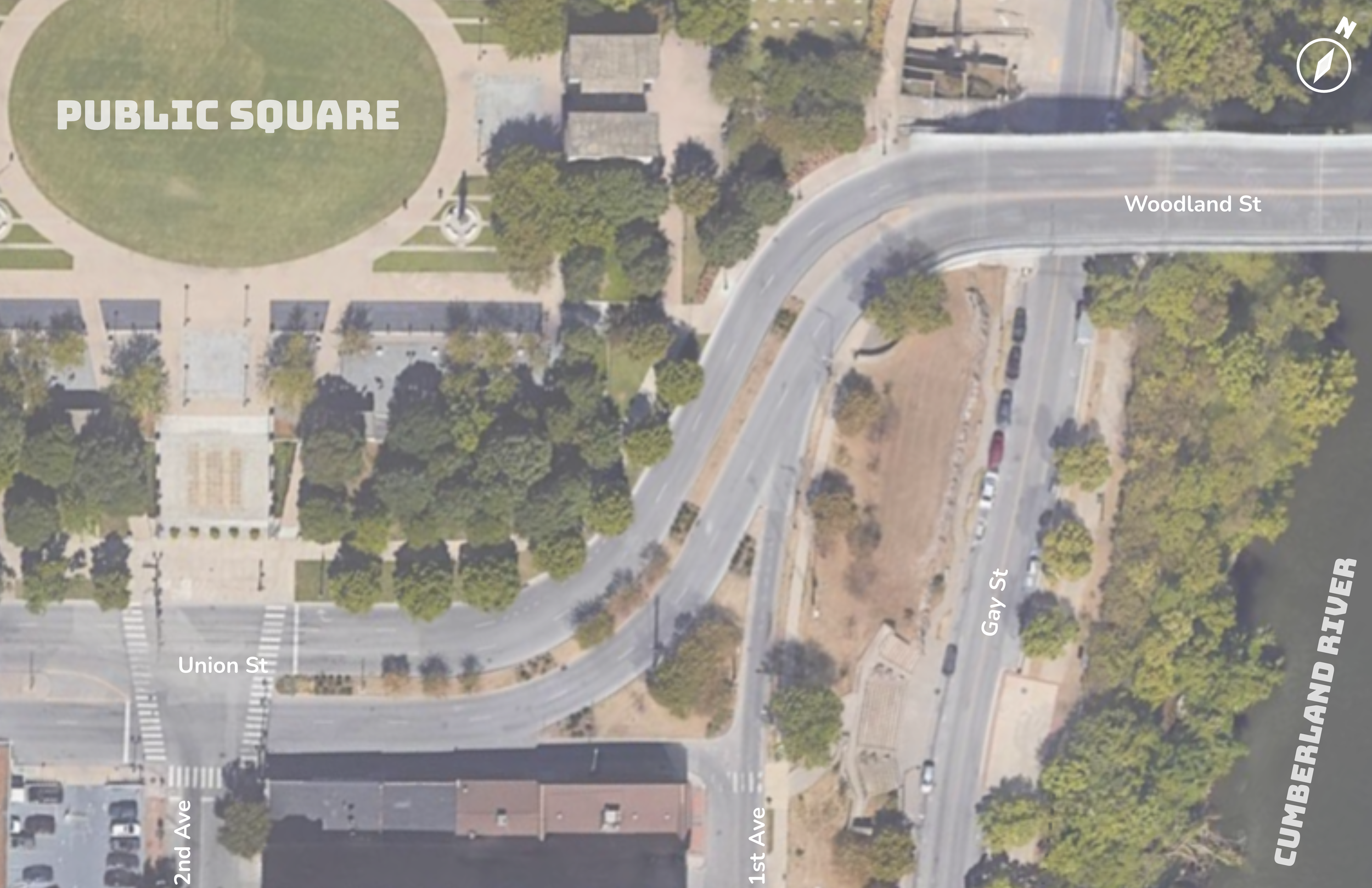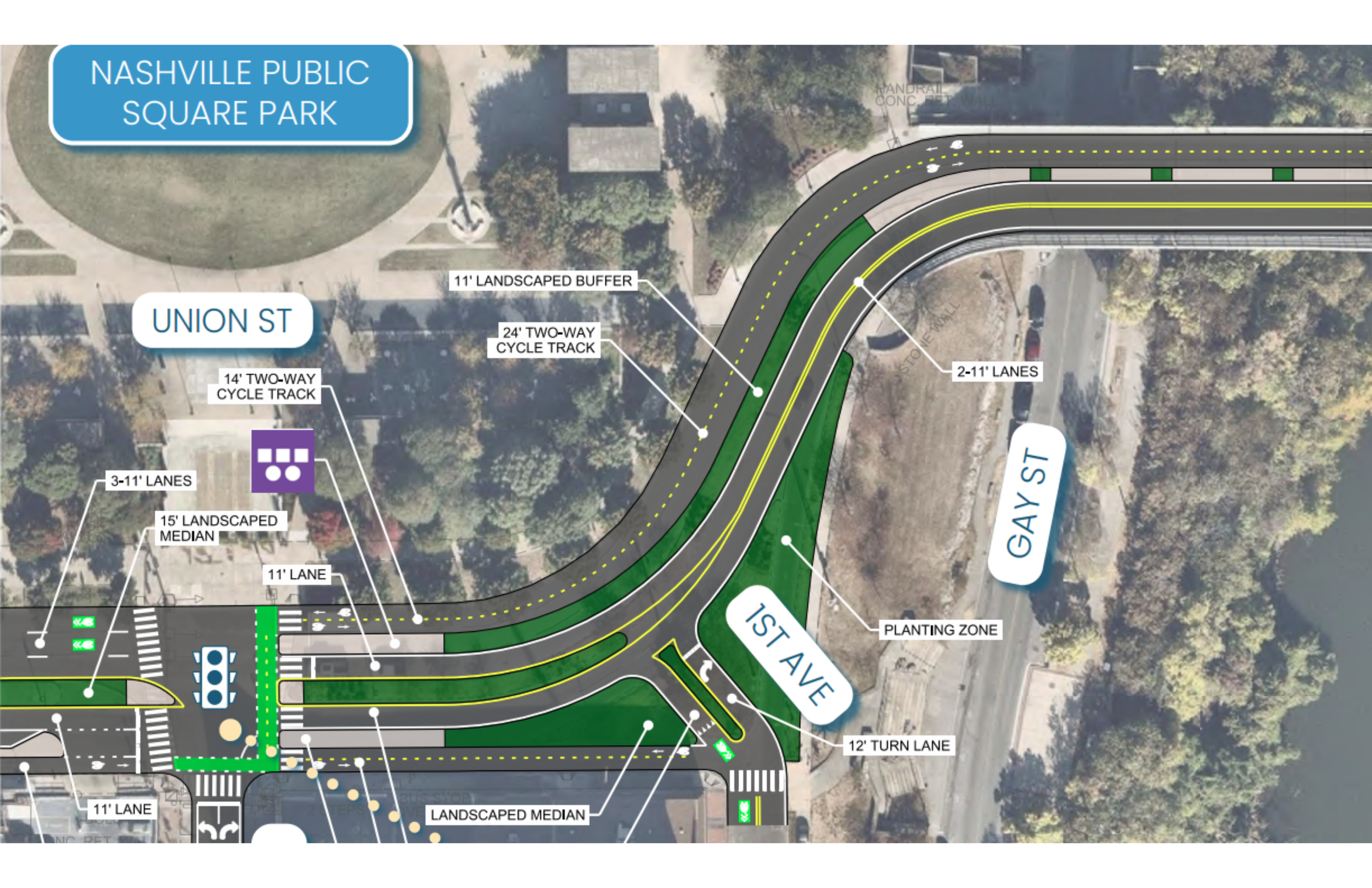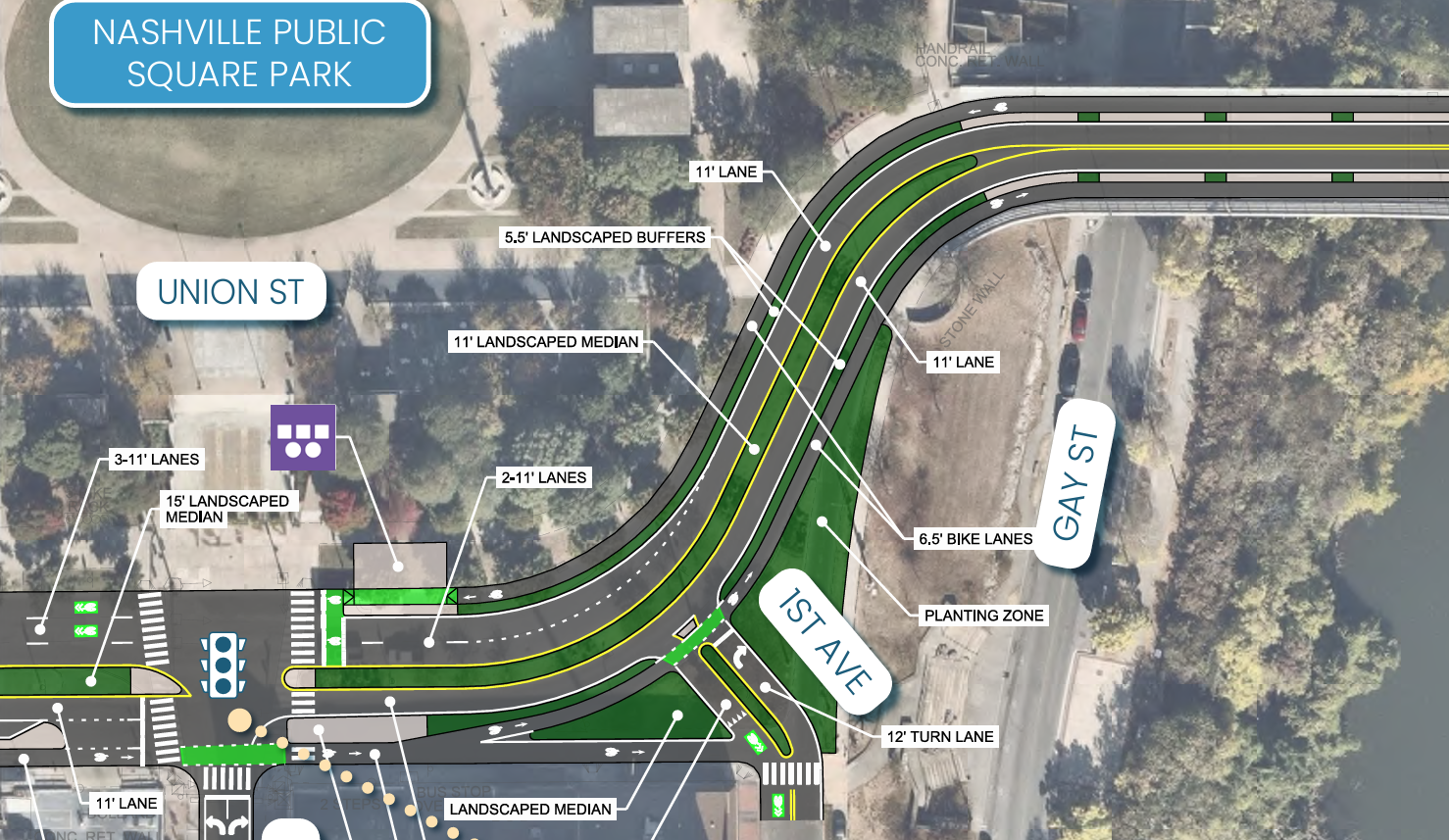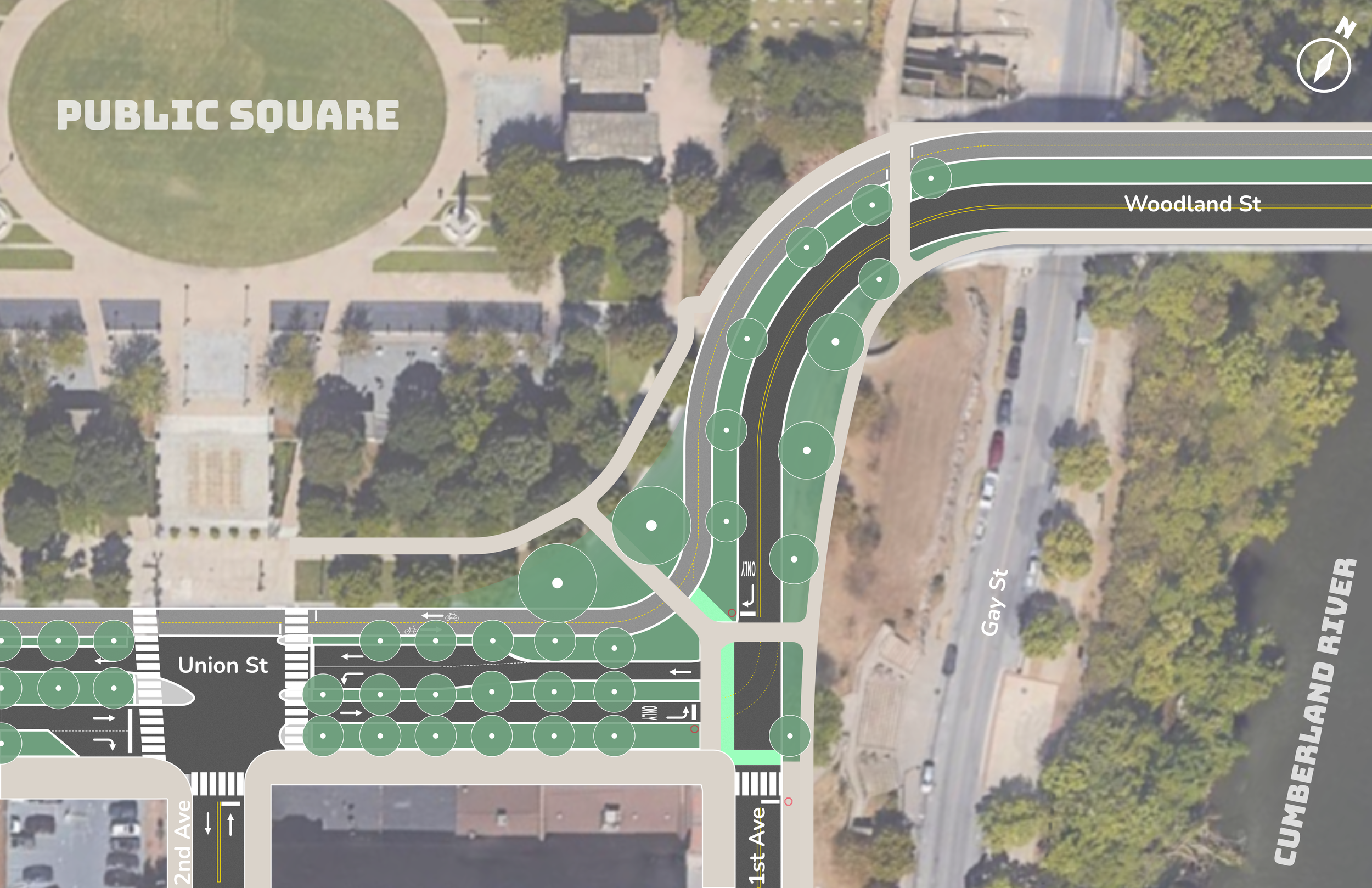Calling for a Multimodal Downtown
By Veronica Foster, Communications + Advocacy Manager | Eric Hoke, Design Director
10 min read The following blog is our response to the Draft Connect Downtown Action Plan. We highly encourage you to explore more information about the project, and read through the Executive Summary at minimum before proceeding. Metro Nashville is collecting feedback about the Plan, but you can also comment below to share your feedback publicly.
Tanisha Hall and Marty Sewell present during the Evaluating Connect Downtown Urban Design Forum
We are in support of Connect Downtown’s goals to reduce car trips Downtown, move people efficiently by reducing congestion and encourage healthier and more equitable forms of transportation. In addition to our support of this Plan, we will be advocating for dedicated funding for transit to move this vision forward.
The Plan aims to make 5 Big Moves: 1) Manage Congestion, 2) Improve Safety, 3) Move More People, 4) Create Complete Networks, and 5) Maximize the Curb. It is important to note that this Plan prioritizes elements that do not need to be designed in order to start making some improvements while those processes happen. Every corridor will need to be designed, so the Plan is only the jumping off point for our detailed design ideas. We hope to be included in Nashville Department of Transportation (NDOT)’s process to fine-tune our streetscapes.
On November 29, 2023, we hosted NDOT and consultants, Fairpointe Planning and Nelson/Nygaard to share an overview of the Draft Plan with the public during our Urban Design Forum, Evaluating Connect Downtown.
Queue jump lanes are short bus lanes at intersections that provide buses with space to bypass queued traffic at red lights. They are developed in curb lanes and do not require the conversion of general-purpose lanes.
Traffic and congestion management in Downtown is critical as Nashville continues to play host to large events in major venues in the area. We are hopeful that through the Plan’s proposed right-of-way management, car travel will be less inhibited by rideshare pick-up and drop-off idling in the middle of a lane. Making transit move faster than car traffic could be a major draw for Downtown visitors to take the bus instead of rideshare to get home from their night out. We are hopeful about the proposed Queue-Jump lanes and the Transit Priority Corridors (TPCs), but we have some concerns when it comes to proposed multimodal improvements. Walking and biking are currently the fastest way to get around the Downtown core for certain times and distances due to traffic. With improvements, these active transportation modes should still be preferred and prioritized methods. Especially when Vision Zero is an umbrella goal for NDOT, any safety updates to the pedestrian infrastructure should make it an enjoyable experience to get through Downtown by walking and rolling.
Within this blog, we also refer to our feedback for the East Nashville Spokes Plan which is deeply intertwined with Connect Downtown’s Draft Plan. Connect Downtown’s proposed bus rerouting as well as the directional conversion of 2nd Ave both affect the Spokes Plan for Union Street and we address solutions for those adjustments.
Getting People to Transit
Transit Priority Corridors (TPCs) have dedicated bus lanes and transit- priority signals to move buses through traffic faster. Connect Downtown reroutes all buses to the edges of the entertainment district (James Robertson, 8th Ave, Korean Veterans Blvd), except for 4 buses that will use Queue Jump Lanes.
By rerouting the TPCs to the edge of the Downtown core, the Plan makes it so that people interested in bus commuting may have to walk a long distance to get to their stop. Our rough calculations suggest that the walk may be as long as 15 minutes to the closest mobility center rather than being able to walk to a selection of major bus stops. With our existing frequency of buses, transferring from one of the 4 central routes remaining within the loop is bound to feel daunting. While we hope that the Queue-Jump routes will be a well-oiled machine of frequency, efficiency, and comfort, we must anticipate that less experienced transit riders may feel more comfortable walking instead of making a transfer.
Most routes within the Downtown core are being rerouted to the loop, so commuters may now have to walk further (if a transfer is not made) to reach a transit station or another stop along the corridor. While the Plan alludes that biking or scootering could be a quick option to get to those stops, no plans have been suggested for scooter corrals, bike racks, or new and/or repositioned, BCycle stations. As indicated by the Plan, curb space is at a premium, so they must be considered or they will be left out of future development efforts as we have seen in Nashville in the past. At the Forum, avid bike commuter, Pete Westerholm of GNRC, raised bike storage in Downtown as a specific concern of his.
Intuitive Active transport system
Connect Downtown’s proposed Mobility Lanes are interrupted by the entertainment district
In the current iteration of the Plan, there is not a single corridor proposed where there is a continuous mobility lane North/South through Downtown. When a mobility lane stops, a biker will inevitably have to navigate complex traffic for a few blocks when there are going to be a lot of vehicles pulling into recommended loading/passenger pick-up zones. On the other hand, people will have to jog around to other streets with protected cycling facilities, but this requires a rider (possibly not comfortable riding on a street without protected lanes) to know the area well enough to navigate those stretches. If we are hoping to promote biking for new cyclists Downtown, we need to design an uninterrupted intuitive system.
The Walk N Bike Plan outlines 3rd Ave N/S in their 2022-2024 Work Plan for Bikeway, specifying a unified bikway from Broadway to Union. While this is distinctly left out of the Connect Downtown Plan, NDOT’s Marty Sewell alluded that their proposed loading zone plan is not permanent and the Walk N Bike Plan will not be changed. It will be critical to continue advocating to fill this bikeway gap as Sewell mentioned that one of the reasons we don’t have a lot of Downtown bikers is due to the disconnect in our current system.
We also hope to see some evolutions of the Plan in the design phase when it comes to the 3rd Ave mobility lanes North of Union. We disagree with the separation of N/S mobility lanes on both 2nd and 3rd Aves going one way. There is room on 3rd Ave for 2 directions of mobility lanes, and the Music City Bikeway is already one block away from 2nd Ave.
Speaking of the Music City Bikeway, while mobility lanes are planned for 1st Ave to connect to the greenway, we think 1st Ave is a missed opportunity for a major micromobility corridor. When the design process is underway, we highly recommend that 1st Ave becomes a coplanar slow street or a greenway trail that is designated and separate from the sidewalk.
Finally, based on the East Nashville Spokes Plan, Union Street mobility lanes should be reviewed carefully. Because the buses will be rerouted to the transit loop, there is more space on Union Street to complete an uninterrupted 2-way bike lane from East Nashville all the way to Rosa Parks Blvd. This would be transformational for bike commuting into Downtown.
Prioritize The Pedestrian Experience
Ultimately, not everyone is comfortable or has the ability to ride a bike. Plus, not everyone will be open to taking public transportation at all if it means they are required to transfer. The pedestrian experience needs to be premium to promote active transportation. We appreciate the Plan’s “Big Move” to improve safety through Leading Pedestrian Intervals and eliminating Right on Red in Downtown, but the pedestrian experience goes beyond safety. The Plan should be addressing comfort and efficiency for pedestrians, too.
We believe that there should be more comfortable places for rest in Downtown for those who may be walking up to 15 minutes to get to and from a Mobility Center. One suggestion would be to implement public seating and/or parklets for places to sit or roll a wheelchair or stroller without disrupting the flow on the sidewalk. Due to the high demand of the curb, it is essential that this be considered in the design phase of the Plan.
Ideas from 2nd Ave Community Engagement around Commerce St
We also highly recommend replacing low-traffic corridor traffic lights with stop signs. For instance, at 2nd Avenue and Commerce, this 3-way intersection has fairly low traffic counts, so a 3-way stop sign would move both people and cars through the intersection faster. With planned speed tables and mid-block crossings for 2nd Ave, this will be a slow-moving street, so we don’t think a stop sign would be a problem with the new 2-way conversion.
Referring back to the East Nashville Spokes Plan, we recommend reconfiguring the 1st Ave, Union St, Woodland St Bridge connection point to eliminate the slip-lane and slow vehicles by creating a 3-way intersection with stop signs. This is currently a difficult place for pedestrians to cross to and from the Riverfront. More crosswalks need to be implemented across Union and Woodland Streets to promote walkability.
Achieving Symbiosis between tourists and commuters
Connect Downtown proposes a flexible system for curb management that changes throughout the day with specific zones for taxi and ridehail
Another “Big Move” of the Plan is to Maximize the Curb, which requires a very well-coordinated effort between loading and unloading as well as passenger pick-up needs for Downtown. The process will be very critical to mitigating traffic. However, with increased fees and complicated permits, ride-hail might significantly rise in cost, adding an additional burden for local users.
There are a significant amount of Downtown employees who work in the entertainment district and need to get home at the end of late nights. Having to walk up to 15 minutes in the dark to the closest bus station does not provide anyone—tourists or employees alike—with a sense of safety. This will inevitably promote taxi and ride-hail services rather than promote an affordable, safe option to get to the place you are staying. While areas for ride-hailing are necessary, it is more sustainable and traffic-mitigating if we can encourage visitors and employees to walk and take transit on their way home. During the Forum, Sewell echoed our concerns and explained that there would be efforts to navigate solutions for this.
We highly recommend that the solution is directly incorporated into the street design when we reach that phase. Corridors leading to transit should have well-lit advertising, bus maps, and wayfinding to encourage visitors to make a multimodal connection back to their hotel or short-term rental with the increase of frequent service for up to 24 hours. The marketing plan should also include benefits for taking the bus. Downloading the QuickTicket app is a barrier for tourists, so if there is a way to make all Downtown transit free after a certain time, that effectively eliminates that barrier.
Let’s literally and figuratively light the way for people to get to the transit loop. For example, a proposed advertisement may say, “Your rideshare may take up to 20 minutes to arrive due to increased traffic and closed roads. Right now, you are a 5-minute walk from the nearest bus station. Take the bus for free after 10 pm.” All corridors that align with a bus stop should be well-lit. There could even be opportunities for placemaking with music playing through sculptures—continuing the party and sense of safety the whole way to the bus. An extra step would be to provide emergency call kiosks at various points on the walking route.
The final recommendation for creating symbiosis between potential tourist and commuter ridership lies with the Queue-Jump Lanes and Riverfront Station. At certain hours (late night and commuting hours), Queue-Jump Lane buses could be free to encourage fast onboarding. In addition, there should be a few more local/low frequency buses that run through the Queue-Jump Lanes, so riders who depend on these buses don’t have to worry about transferring and missing their bus at a Mobility Center. These are already slower moving routes, so it doesn’t have to be an added burden to the system. Additionally, Riverfront Station could be better utilized as a hub for public shuttles that get you to a Mobility Center. If these shuttles were regular enough, then this implementation would complete the transit circulation better.
Tuning the Network
Because Downtown cannot operate in a silo, another thing that will make our future transit system more intuitive would be to link Nashville’s neighborhoods by one-seat rides. Nashville is currently a hub and spoke system (meaning most routes connect through Downtown) and it would be great to start adding more crosstown routes to our system, which is part of the Better Bus Plan and is also a recommendation of N Motion. However, it will be hard to justify high frequency of buses on these routes because ridership will be low compared to most others (for example the #77 comes once an hour). The new Mobility Centers suggested in Connect Downtown Plan will provide the opportunity for more service on new routes and more buses in the fleet to make it feasible to link high-capacity corridors with one-seat rides.
Civic Design Center's Proposed Future BRT Network Map
The idea for branding the Connect Downtown transit priority corridors as “The Pick” as it makes a guitar pick-like shape with the point being the future Sobro Mobility Hub.
The Connect Downtown Plan ultimately routes most transit around the “entertainment district” due to road width constraints, closures, and special events. “The Pick” idea (shown above) is an example of how to create a Downtown Nashville transit identity that is unified with Nashville’s primary identity of “Music City.” Marketing is a critical component to getting new ridership to fulfill our foundational Guiding Principle to promote the “development of equitable and desirable transportation infrastructure.” The system needs to be affordable, accessible, efficient, convenient, and safe—we aren’t asking for a lot! Joking aside, the Connect Downtown Plan can get us closer to our goals.
In addition to encouraging transit, how can we mitigate the number of road closures for continued transit service and sustained walkability through Downtown? We don’t have to keep operating under the assumption that the areas around Broadway will always be closed. What is the cost-benefit between festival entertainment and continued street connections? On the other hand, if Lower Broadway was just permanently closed to cars—other than loading vehicles at key times—we could eliminate confusion about whether the streets are open in an entirely different way. Francois DeKock of Barge Design Solutions brought this idea to the Forum Q&A and we think this could be seriously considered and tested with tactical urbanism.
Ultimately, this begs the question, what is the real priority for experiencing Downtown, not just getting through it?
We applaud the whole team at NDOT, Fairpointe Planning, and Nelson/Nygaard for the amount of energy they have put into this project. We are avid supporters of a mutlimodal Downtown, so share your feedback on the Draft Plan before December 22nd and comment publicly below.
Ashley Bergeron of Swipe Right Art and The Studio 208 raises a question at the Evaluating Connect Downtown Urban Design Forum






